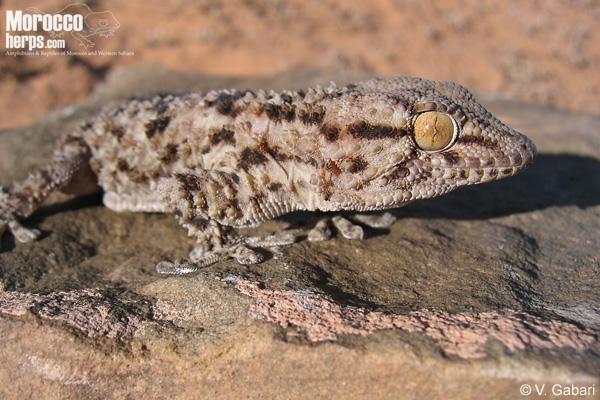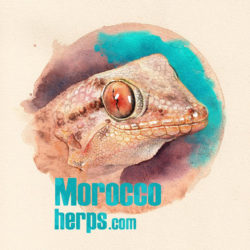Desert Wall Gecko
Tarentola deserti Boulenger, 1891
By Victor Gabari
Updated: 23/09/2012
Taxonomy: Sauria | Phyllodactylidae | Tarentola | Tarentola deserti


 Tarentola deserti
Tarentola deserti
Distribution map of
Tarentola deserti
in Morocco.
Description
Big size geckonids, SVL around 100 mm (males) and 81 (females), and total length 190 mm. Very flat and broad head and rounded snout. Scales around midtrunk, dorsal tubercles prominent and pointed. Pholidosis identification, 21-24 lamellae and scales under 5 th toe (Schleich et al, 1996).

Dorsal coloration lightly pink, flesh coloured, orange, beige to reddish with pattern of 5-7 transversal bars which are often reduced to patches or lack altogether. Iris yellowish ocre (Schleich et al, 1996).
Ecology and habits
Activity pattern crepuscular and nocturnal, and both sex are territorial. They detect their prey at 1m distance from which they approach cautiously until they can capture their prey with a lightning movement, allowing you to bite his victim while adhering to the substrate with their hind limbs (Schleich et al, 1996).

Food spectrum: All small insects, particularly noctuid moths (Schleich et al, 1996).
For reproduction mating, male approaches female, tongues her and takes a bite-hold at a tubercle behind the ear-opening. The female lifts her tail base, and cloacal contact last 20-60 seconds on one side. The male then copulates from the other side without loosening his grip (Schleich et al, 1996).
4-6 clutches per year with mostly 2 eggs (Joger, U., Slimani, T., El Mouden, H. & Geniez, P. 2006).
Distribution, habitat and abundance
Geographic range: Algeria, Morocco, Tunisia and Libya (Joger, U., Slimani, T., El Mouden, H. & Geniez, P. 2006). Primarily concerned into Sahara biotope and not usually present in areas with rainfall below 100 mm annually. (Schleich et al, 1996). It is found up to 1,300 masl (IUCN – Centre for Mediterranean Cooperation IUCN-Med).

This is an adaptable species that is found in rocky areas, deserts with firm ground (regs), drains under roads, palm oasis, ruins, buildings and is also found close to sandy deserts (ergs) with trees. Animals are found in crevices and fissures.
References
- Bons, J. & Geniez, P. 1996. Anfibios y Reptiles de Marruecos (Incluido Sahara Occidentales). Atlas Biogeográfico. Asociación Herpetológica Española. Barcelona. 319 pp.
- Schleich, H.H., Kästle, W. & Kabisch, K. 1996. Amphibians and Reptiles of North Africa. Biology, Systematics, Field Guide. Koeltz Scientific Books. 630 pp.
- Joger, U., Slimani, T., El Mouden, H. & Geniez, P. 2006. Tarentola deserti. In: IUCN 2011. IUCN Red List of Threatened Species. Version 2011.1.http://www.iucnredlist.org/apps/redlist/details/61576/0
- IUCN – Centre for Mediterranean Cooperation IUCN-Med.http://iucn.org/about/union/secretariat/offices/iucnmed/
To cite this page:
Victor Gabari (2012): Tarentola deserti Boulenger, 1891. In: Martínez, G., León, R., Jiménez-Robles, O., González De la Vega, J. P., Gabari, V., Rebollo, B., Sánchez-Tójar, A., Fernández-Cardenete, J. R., Gállego, J. (Eds.). Moroccoherps. Amphibians and Reptiles of Morocco and Western Sahara.
Available from www.moroccoherps.com/en/ficha/Tarentola_deserti/. Version 23/09/2012.
To cite www.morocoherps.com en as a whole:
Martínez, G., León, R., Jiménez-Robles, O., González De la Vega, J.P., Gabari, V., Rebollo, B., Sánchez-Tójar, A., Fernández-Cardenete, J.R., Gállego, J. (Eds.). Moroccoherps. Amphibians and Reptiles of Morocco and Western Sahara.
Available from www.moroccoherps.com.

